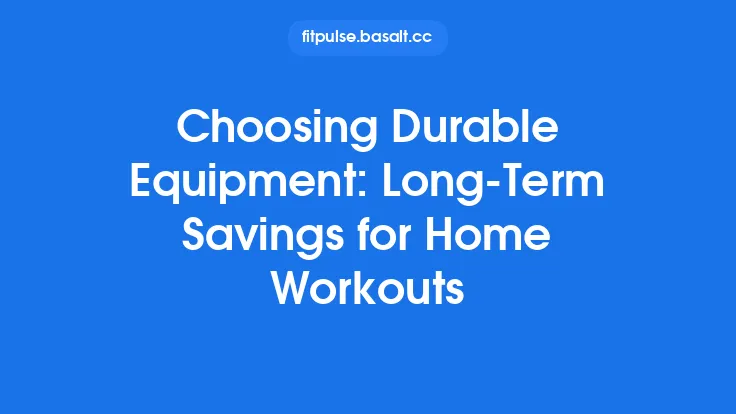Choosing the right indoor cardio equipment for your home gym is a decision that blends personal fitness objectives, spatial realities, technical specifications, and long‑term value. While the market offers a dizzying array of treadmills, ellipticals, stationary bikes, rowers, and hybrid machines, a systematic approach can turn the selection process from overwhelming to empowering. Below is a comprehensive guide that walks you through each critical factor, helping you build a home cardio setup that remains effective, enjoyable, and sustainable for years to come.
Assessing Your Fitness Goals and Training Style
Before you even glance at a product catalog, clarify what you want to achieve and how you prefer to train.
| Goal | Ideal Modalities | Reasoning |
|---|---|---|
| Endurance building (long steady‑state sessions) | Treadmill, upright bike, rowing machine | These machines support continuous, low‑impact motion for 60 + minutes. |
| High‑intensity interval training (HIIT) | Elliptical, assault bike, air‑resistance rower | Rapid power output and quick resistance changes enable short, intense bursts. |
| Low‑impact joint‑friendly cardio | Elliptical, recumbent bike, water rower | The motion minimizes stress on knees, hips, and ankles. |
| Full‑body conditioning | Rowing machine, cross‑trainer (elliptical with arms) | Simultaneous upper‑ and lower‑body engagement maximizes caloric burn. |
| Rehabilitation or beginner fitness | Recumbent bike, low‑step treadmill, low‑resistance elliptical | Adjustable stride length and supportive seating reduce strain. |
Write down your primary goal(s) and rank them. This hierarchy will guide you toward the equipment class that aligns most closely with your intended outcomes.
Evaluating Space and Layout Constraints
Indoor cardio equipment varies dramatically in footprint, ceiling clearance, and required clearance for safe operation. Conduct a room audit before purchasing:
- Measure the floor area – Include a 2‑foot buffer around the machine for user movement and maintenance access.
- Check ceiling height – Particularly important for treadmills with inclined decks and rowing machines with full‑stroke motion. A minimum of 8 ft is advisable for most rowers.
- Consider floor load capacity – Heavy treadmills and commercial‑grade ellipticals can weigh 300 lb or more; ensure the subfloor can support the load without flexing.
- Plan for power outlets – Machines with electronic consoles require dedicated circuits to avoid tripping breakers.
- Think about ventilation – Even though you’re staying indoors, a well‑ventilated space reduces perceived exertion and helps equipment stay cool.
If space is at a premium, look for foldable or compact models (e.g., folding treadmills, vertical‑storage ellipticals) that can be stored when not in use.
Understanding Equipment Types and Their Mechanical Differences
1. Treadmills
- Drive System: Motor‑driven belt (continuous loop) vs. manual (self‑propelled).
- Key Specs: Motor horsepower (continuous rating), belt size, incline range, shock‑absorption technology.
- Use Cases: Running, walking, sprint intervals, incline training.
2. Ellipticals (Cross‑Trainers)
- Drive System: Flywheel (magnetic, electromagnetic, or friction) that creates resistance.
- Key Specs: Flywheel weight, resistance levels, stride length, rear‑vs‑front‑drive design.
- Use Cases: Low‑impact cardio, full‑body motion (if equipped with moving handles).
3. Stationary Bikes
- Categories: Upright, recumbent, and air‑resistance (assault) bikes.
- Drive System: Magnetic (quiet, adjustable), friction (budget‑friendly), or fan‑based (self‑regulating resistance).
- Key Specs: Pedal cadence range, seat adjustability, crank length, resistance steps.
- Use Cases: Cycling simulation, HIIT, rehabilitation.
4. Rowing Machines
- Drive Systems: Air (fan), magnetic, water, or hydraulic.
- Key Specs: Flywheel weight (air), water tank volume (water), resistance levels, seat travel.
- Use Cases: Full‑body cardio, strength‑endurance, low‑impact high‑output training.
5. Hybrid Machines (e.g., SkiErg, VersaClimber)
- Mechanics: Simulate specific activities (cross‑country skiing, climbing).
- Key Specs: Resistance type, range of motion, grip ergonomics.
- Use Cases: Niche conditioning, sport‑specific training.
Understanding these mechanical foundations helps you compare durability, maintenance needs, and the feel of each workout.
Key Performance Metrics and How to Compare Machines
When evaluating specifications, focus on objective performance metrics rather than marketing buzzwords:
| Metric | Why It Matters | Typical Benchmarks |
|---|---|---|
| Motor Continuous Horsepower (HP) | Determines ability to sustain high speeds/inclines without overheating. | 2.0 HP (home) – 4.0 HP (commercial) for treadmills. |
| Flywheel Weight (lb) | Heavier flywheels provide smoother resistance and momentum. | 15–30 lb for ellipticals; 20–30 lb for rowing machines. |
| Resistance Levels | Number of discrete steps or range of resistance. | 12–20 levels for magnetic bikes; 0–20% incline for treadmills. |
| Stride Length (inches) | Affects natural gait and comfort. | 18–22 in for ellipticals; 20–22 in for treadmills. |
| Maximum User Weight | Safety and durability ceiling. | 250–350 lb typical; higher for commercial models. |
| Noise Decibel Rating (dB) | Impacts household comfort and neighbor relations. | 65 dB (quiet) – 80 dB (louder) for treadmills; <70 dB for magnetic bikes. |
| Console Accuracy | Reliability of speed, distance, and calorie readouts. | Look for machines with calibrated sensors and firmware updates. |
Create a comparison spreadsheet using these metrics to objectively rank candidates.
Technology Integration and Data Tracking
Modern cardio equipment often doubles as a data hub. While you don’t need every feature, consider the following integrations:
- Bluetooth & ANT+ Compatibility – Allows connection to heart‑rate monitors, smartwatches, and third‑party apps (e.g., Zwift, TrainerRoad).
- Built‑In Power Meters – Particularly on air‑resistance bikes and rowing machines; provides precise wattage output for performance tracking.
- Interactive Screens – Touchscreen consoles can stream training programs, virtual routes, or entertainment. Ensure the screen is replaceable or upgradable.
- Software Ecosystem – Some brands (e.g., Peloton, NordicTrack) lock you into subscription services. Evaluate whether you prefer an open platform (e.g., compatible with MyFitnessPal, Strava) or a proprietary ecosystem.
- Firmware Updates – Machines that receive regular software updates tend to stay functional longer and fix bugs.
If data-driven training is a priority, prioritize equipment with robust connectivity and open APIs.
Noise Levels and Neighbor Considerations
Even in a private home gym, acoustic impact matters for household harmony. Noise originates from three primary sources:
- Motor/Drive System – Magnetic resistance and brushless motors are the quietest.
- Impact Noise – Treadmills generate footfall sounds; look for models with advanced cushioning decks and rubberized belt systems.
- Vibration Transmission – Heavy machines can vibrate through flooring. Use anti‑vibration pads or place equipment on a rubber mat.
Check manufacturer specifications for decibel ratings and, if possible, test the machine in a showroom. A difference of 5 dB can be perceptible in a quiet home environment.
Maintenance, Longevity, and Warranty
Long‑term reliability hinges on maintenance requirements and warranty coverage:
- Lubrication – Treadmills and some ellipticals require periodic belt lubrication. Machines with sealed bearings reduce this need.
- Cleaning – Rowing machines with water resistance need occasional tank cleaning to prevent algae.
- Part Replacement – Look for readily available belts, decks, or flywheels. Brands with extensive dealer networks make sourcing parts easier.
- Warranty – Ideal warranties cover the frame (10+ years), motor (5–7 years), and parts (2–3 years). Extended service plans can be worthwhile for high‑use households.
- User Serviceability – Machines that allow user‑level adjustments (e.g., tightening bolts, swapping resistance modules) reduce downtime.
A well‑maintained machine can exceed its expected lifespan by 30–50 %.
Budgeting and Cost‑Benefit Analysis
While price tags vary widely, a cost‑benefit framework helps you justify the investment:
- Initial Purchase Price – Compare base models vs. premium bundles (e.g., added console, accessories).
- Operating Costs – Electricity consumption (especially for high‑horsepower treadmills) and potential subscription fees.
- Depreciation – Estimate a 5‑year useful life; calculate annualized cost.
- Alternative Expenses – Gym memberships, class fees, or outdoor gear (shoes, clothing).
- Health ROI – Quantify potential health savings (reduced medical visits, improved productivity) using published data on cardio benefits.
A mid‑range treadmill (~$1,200) with a solid warranty may offer a better ROI than a low‑cost elliptical that requires frequent repairs.
Accessibility and Adaptability for Different Users
Your home gym may serve multiple users—different ages, fitness levels, or physical limitations. Choose equipment that adapts:
- Adjustable Stride/Seat – Allows taller and shorter users to find a comfortable position.
- Step‑Up/Step‑Down Options – Some treadmills feature low‑step entry or detachable side rails for easier mounting.
- Resistance Customization – Machines with fine‑grained resistance steps (e.g., 1% increments) accommodate both beginners and elite athletes.
- Handrails and Grip Options – Essential for seniors or those recovering from injury.
- Modular Add‑Ons – Interchangeable pedals, arm handles, or heart‑rate strap mounts increase versatility.
A versatile machine reduces the need for multiple devices, saving space and money.
Final Decision Framework and Implementation Tips
- Define Priorities – Rank the categories above (goal, space, noise, tech, budget) according to personal importance.
- Shortlist Candidates – Use the performance metric spreadsheet to narrow options to 2–3 models.
- Test In‑Person – If possible, try each machine for at least 5–10 minutes to assess feel, ergonomics, and noise.
- Verify Warranty & Service – Confirm coverage details and locate the nearest authorized service center.
- Plan Installation – Ensure you have the required floor space, power outlet, and any needed floor protection.
- Set Up Data Integration – Pair the machine with your preferred apps and calibrate sensors before the first workout.
- Create a Maintenance Schedule – Mark quarterly checks for belt tension, lubrication, and firmware updates.
By following this structured approach, you’ll select indoor cardio equipment that not only meets your immediate training needs but also remains a reliable, enjoyable component of your home gym for years to come.





